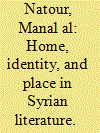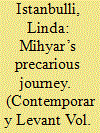|
|
|
Sort Order |
|
|
|
Items / Page
|
|
|
|
|
|
|
| Srl | Item |
| 1 |
ID:
184738


|
|
|
|
|
| Summary/Abstract |
This study explores the juncture of home, liminality and counternarrative in contemporary Syrian literature produced after the eruption of the revolution in 2011. As a case study, I examine how Maha Hassan’s Drums of Love and Ghassan Jubbaʿi’s Qahwat Al-General redefine the concept of home through heterotopic and utopic representations of the place. The study demonstrates that in both works a real sense of home proves unattainable. When the protagonists seek a place for themselves in a home that enjoys freedom and justice, the home denies them. Utilising Bakhtin’s notion of polyphony, I investigate how both works represent a multiplicity of oppressed voices in a ‘home’ that imprisons and estranges everyone. Both texts bear global messages, inviting their readers to examine the complexity of the status quo in Syria through subjecting all-encompassing representations of the revolution and resisting oppression to a process of contestation. Finally, I argue that the unattainable sense of home depicted in the novels marks such texts as a part of the enduring legacy of the Syrian revolution and its causes, and thereby they may foreground solidarity among Syrians who continue to suffer the loss of home.
|
|
|
|
|
|
|
|
|
|
|
|
|
|
|
|
| 2 |
ID:
184733


|
|
|
|
|
| Summary/Abstract |
This article investigates the representations of the literary persona of Mihyar in three works by Syrian authors. First established as a central figure in Arab literary culture by Adonis in his influential 1961 poetry collection The Songs of Mihyar of Damascus, Mihyar embodies the worldviews of the progressive intellectual of the 1950s and 1960s. As it examines Adonis’s Mihyar as well as his ensuing remobilisation in Haydar Haydar’s Banquet for Seaweed (1983) and Rosa Yasin Hasan’s First Draft (2011), this article calls attention to the implications of their literary re-makings in relation to fluctuating cultural and political conditions. I argue that both Adonis and Haydar assume the persona of Mihyar to model their idealised version of the public intellectual in their own image, whereas Hasan incorporates the figure of Mihyar into her novel to dismantle him entirely. By so doing, First Draft interrogates the totalising models of sovereign paternalism that a previous generation of intellectuals had produced and the genealogy they had constructed for Arab modernity. Hasan’s work speaks to the preoccupations of a new generation of Syrian writers who share an overwhelming sense of disillusionment with both the grand narratives that had governed the cultural field and the epistemological frameworks that had given rise to these narratives.
|
|
|
|
|
|
|
|
|
|
|
|
|
|
|
|
| 3 |
ID:
184737


|
|
|
|
|
| Summary/Abstract |
Labelled a novel (riwāya) on the cover, the text Marathi al-Ayyam: Thalath Hikayat ʿan al-Mawt (2001), the author Haydar Haydar tells us in the prologue, or what he calls ‘ishāra’ (gesture, sign), is a novel that structurally is not a novel. It is also, he writes, not a collection of stories united by the theme of death. This cryptic disavowal by one of Syria’s preeminent authors of short stories and novels is suspicious. This essay takes up the task of suggesting a reasonable classification as a means of understanding Haydar’s intervention in the literary field, one which he was instrumental in constructing. While intertextuality plays a significant role in one of the ḥikāyāt, there is also narrative prose, as well as cut and paste selections from historical documents. I argue that the text uses foundational tools of collage, such as juxtaposition, disruption, and a fundamental sense of anti-narrativity, and, as such, chips away at the calcified trajectory of Syrian political-literary discourse. As a foundational medium in radically shifting perceptions, collage questions existing modes of representation. Haydar’s selections, insertions, and placement of particular histories against Syrian narratives pose a corrective lens to the Syrian historical imaginary that has been locked in a determinist trajectory, and, as this essay will demonstrate, frees texts from the responsibility of narrativity to a more aesthetically-charged act of formal innovation.
|
|
|
|
|
|
|
|
|
|
|
|
|
|
|
|
|
|
|
|
|